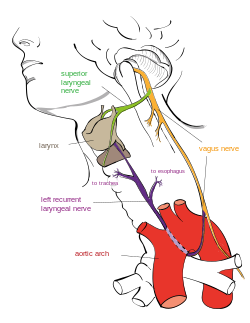
Back Polyvagal-Theorie German Teoría polivagal Spanish نظریه چند واگی Persian ポリヴェーガル理論 Japanese Teoria polivagala Occitan Поливагальная теория Russian
This article has multiple issues. Please help improve it or discuss these issues on the talk page. (Learn how and when to remove these messages)
|

Polyvagal theory (PVT) is a collection of proposed evolutionary, neuroscientific, and psychological constructs pertaining to the role of the vagus nerve in emotion regulation, social connection and fear response. The theory was introduced in 1994 by Stephen Porges.[1] There is consensus among experts that the assumptions of the polyvagal theory are untenable.[2] PVT is popular among some clinical practitioners and patients,[3] but it is not endorsed by current social neuroscience.[4][5][6][7][8][9]
Polyvagal theory takes its name from the vagus nerve, a cranial nerve that forms the primary component of the parasympathetic nervous system.[10][11][12] The traditional view of the autonomic nervous system presents a two-part system: the sympathetic nervous system, which is more activating ("fight or flight"), and the parasympathetic nervous system, which supports health, growth, and restoration ("rest and digest").[13] Polyvagal theory views the parasympathetic nervous system as being split into two distinct branches: a "ventral vagal system" which supports social engagement, and a "dorsal vagal system" which supports immobilisation behaviours, both "rest and digest" and defensive immobilisation or "shutdown". This "social engagement system" is a hybrid state of activation and calming that plays a role in the ability to socially engage.[14]
- ^ Cite error: The named reference
Porges95was invoked but never defined (see the help page). - ^ Cite error: The named reference
Grossman23was invoked but never defined (see the help page). - ^ "Polyvagal theory in practice". Counseling Today. 2016-06-27. Retrieved 2020-10-31.
- ^ Todorov, Alexander; Fiske, Susan; Prentice, Deborah (2011). Social Neuroscience: Toward Understanding the Underpinnings of the Social Mind. Oxford University Press. ISBN 978-0-19-972406-2.[page needed]
- ^ Ward, Jamie (2016). The Student's Guide to Social Neuroscience. Psychology Press. ISBN 978-1-317-43918-9.[page needed]
- ^ Schutt, Russell K.; Seidman, Larry J.; Keshavan, Matcheri S. (2015). Social Neuroscience: Brain, Mind, and Society. Harvard University Press. ISBN 978-0-674-72897-4.[page needed] Litfin, Karen T.; Berntson, Gary G. (2006). Social Neuroscience: People Thinking about Thinking People. MIT Press. ISBN 978-0-262-03335-0.[page needed]
- ^ Baron-Cohen, Simon; Tager-Flusberg, Helen; Lombardo, Michael (2013). Understanding Other Minds: Perspectives from Developmental Social Neuroscience. Oxford: Oxford University Press. ISBN 978-0-19-969297-2.[page needed]
- ^ Cacioppo, Stephanie; Cacioppo, John T. (2020). Introduction to Social Neuroscience. Princeton University Press. ISBN 978-0-691-16727-5.[page needed]
- ^ Decety, Jean; Cacioppo, John T. (2011). The Oxford Handbook of Social Neuroscience. Oxford University Press. ISBN 978-0-19-534216-1.[page needed]
- ^ Anthony, Andrew. "Stephen Porges: 'Survivors are blamed because they don't fight'". The Guardian. Retrieved 2021-09-17.
- ^ Brookes, David (2019-11-28). "The Wisdom Your Body Knows". The New York Times. ISSN 0362-4331. Retrieved 2021-09-17.
- ^ Quinn, Robert E.; Fessell, David P.; Porges, Stephen W. (2021-01-15). "How to Keep Your Cool in High-Stress Situations". Harvard Business Review. ISSN 0017-8012. Retrieved 2021-09-19.
- ^ Davidson, R. J.; Scherer, K. R.; Goldsmith, H. H., eds. (2003). "The autonomic nervous system and its coordination by the brain". Handbook of affective sciences. London: Oxford University Press. pp. 135–186. ISBN 978-0195377002.
- ^ Porges, Stephen W. (April 2009). "The polyvagal theory: New insights into adaptive reactions of the autonomic nervous system". Cleveland Clinic Journal of Medicine. 76 (Supplement 2): S86 – S90. doi:10.3949/ccjm.76.s2.17. ISSN 1939-2869. PMC 3108032. PMID 19376991.
© MMXXIII Rich X Search. We shall prevail. All rights reserved. Rich X Search